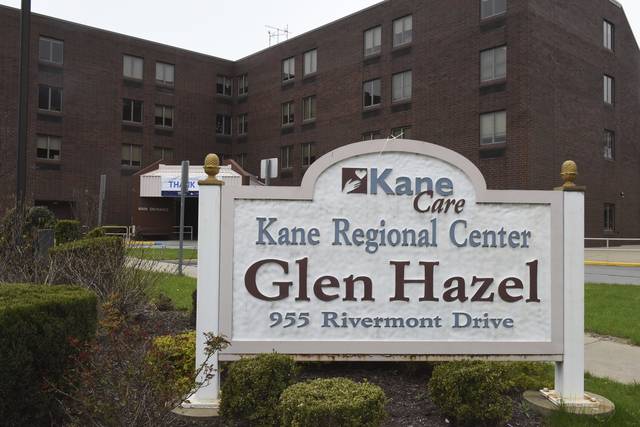https://naviga.triblive.com/news/pennsylvania/leaders-warn-that-coronavirus-cases-at-care-facilities-present-wide-reaching-public-health-concerns/
Leaders warn that coronavirus in care facilities presents wide-reaching public health concern

As coronavirus cases in nursing and personal care homes continue to rise, a growing chorus is calling for those numbers to be recorded separately from the overall number of cases and deaths.
Those cries are getting particularly loud in Pennsylvania, where one of the metrics for easing pandemic-related restrictions focuses on the number of new cases in a county.
Medical experts, however, say despite those particular cases being confined to one building, the public health implications are vast.
“Any outbreak in a nursing home can easily spill into a hospital and put a hospital’s resources under stress, because those people are not likely to have mild cases,” said Dr. Amesh Adalja, a Pittsburgh-based infectious disease specialist and fellow of the Infectious Diseases Society of America. “They’re likely to be more severe illnesses because those individuals often have (multiple chronic diseases), they’re elderly.”
The virus has proven especially deadly in such care facilities.
The congregate living situation, the particular vulnerability of the elderly, often frail residents and the highly infectious nature of the virus creates a perfect storm that has killed thousands.
Across Pennsylvania, just under 2,900 long-term care residents had died as a result of the pandemic through Thursday. That accounted for more than two-thirds of the state’s 4,218 deaths.
Another 12,677 residents had contracted the virus along with 1,922 employees. Of the state’s approximately 1,920 care facilities, 549 — or nearly 29% — have at least one case of covid-19 among their residents.
“It’s not all of them, but it’s a lot of them,” Secretary of Health Dr. Rachel Levine told the Tribune-Review on Thursday. “Long-term care living facilities … for example, nursing homes, really have vulnerable citizens, and they’re congregate settings. Every state has had challenges with those facilities.”
Levine and Gov. Tom Wolf have stood firm in continuing to count long-term care facility cases as part of the state’s overall totals. Levine has said care homes inextricably are enmeshed in the communities in which they’re located.
“Staff live in communities,” Levine told the Trib. “They go home after their day or night at work, they go to the grocery stores, they go to pharmacies to get essential items, and so everything is interconnected with a community, within a county and within the commonwealth.”
All long-term care facilities — nursing homes, personal care homes, assisted living facilities — on Sunday must start reporting detailed daily data on covid-19 cases, deaths and tests. That facility-specific data will be released to the public starting Monday.
State and health officials have balked at releasing such granular data, citing the balance between patient privacy and the public’s right to know.
“We were specifically waiting for this federal guidance so the data we put out is consistent with the data they put out,” Levine said. “It wasn’t that we were trying to hide something in any way.”
The Centers for Disease Control and Prevention and the Centers for Medicaid and Medicare Services have been compiling nursing home figures nationwide for a separate public database set to publish by month’s end.
Beyond the public health implications are the lives of those residents, said Adam Marles, president and chief executive of LeadingAge PA, a trade association that represents more than 360 nonprofit senior living services.
“I think our democracy is built on the idea that every person and every life matters,” he said. “The suggestion that anyone’s life is expendable is outrageous.”
Dr. Debra Bogen, director of the Allegheny County Health Department, gave a similar sentiment.
“They are members of our community, so we should all care about them,” Bogen said this week. “They’re our grandfathers, our mothers, our aunts. So for me, the long-term care facility is a huge and important part of our population, and we need to be paying close attention to them.”
Marles said the continued pleas not just locally but worldwide for personal protective equipment hasn’t just been for the safety of staff — it keeps the residents safe too, he said.
“In the bigger picture sense, if we can’t keep our staff safe, when they leave the facility, they go back to their families, they go back to the grocery store, they go back to the community and potentially could spread the virus in other places,” he said. “So it goes both ways.”
It all goes back to the idea that care facilities are not islands within communities but rather ingrained in them, said Zach Shamberg, president and chief executive of the Pennsylvania Health Care Association. The statewide advocacy group represents more than 500 facilities that care for more than 50,000 residents.
He said the fact that front-line workers come and go every day — plus patients being discharged to home or the hospital — means there are myriad chances for the virus to spread.
“Like it or not, especially if we don’t have testing capabilities, spread is still possible if we don’t mitigate and contain the virus,” he said.
If care facilities can find ways to protect their residents, then those practices can apply to the broader population, Shamberg said.
“That’s why I want to focus our efforts on long-term care,” he said. “If we can mitigate and stop the spread, we can certainly extend that throughout the entire county.”
Copyright ©2025— Trib Total Media, LLC (TribLIVE.com)
